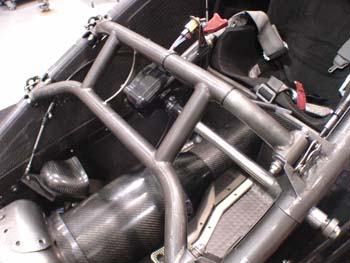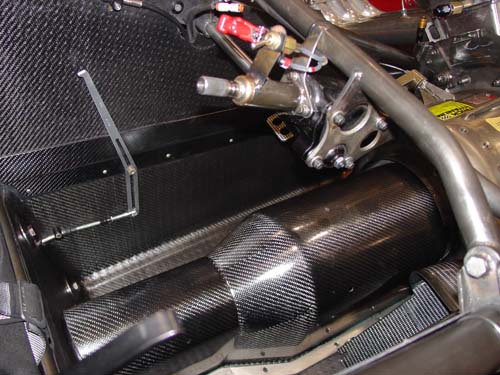AERODINE'S JFR CONTRIBUTION
 into
the existing chromoly chassis that would provide additional protection
to the driver’s lower extremities in the event of a chassis failure.
into
the existing chromoly chassis that would provide additional protection
to the driver’s lower extremities in the event of a chassis failure. John Force Racing through The Eric Medlen Project (TEMP) brought in Aerodine Composite Group, to develop a safety structure that would protect the driver’s lower extremities. John Medlen, director of TEMP, had previously worked with Aerodine Composites and knew they were the perfect company for this critical job.
With input from all of the JFR crew chiefs and chassis builder Murf McKinney, Aerodine Composites was able to develop a lightweight two-piece composite footbox structure built from carbon fiber and ballistic fiberglass that further added to the safety of the cockpit. The initial part was designed, manufactured, and fitted to a chassis in time for NHRA championship contender Robert Hight to race in Richmond, Virginia, less than two weeks after John’s horrific crash. The use of advanced composites allowed Aerodine Composites to add the additional protection required inside an already cramped cockpit, while minimizing weight that could adversely affect the performance of the car.

Following 14-time Funny Car World Champion John Force’s dramatic crash last September in Dallas, a decision was made by John Force Racing to pursue the design and manufacture of an integrated composite safety structure that could be mounted  into the existing chromoly chassis that would provide additional protection to the driver’s lower extremities in the event of a chassis failure.
into the existing chromoly chassis that would provide additional protection to the driver’s lower extremities in the event of a chassis failure.
John Force Racing through The Eric Medlen Project (TEMP) brought in Aerodine Composite Group, to develop a safety structure that would protect the driver’s lower extremities. John Medlen, director of TEMP, had previously worked with Aerodine Composites and knew they were the perfect company for this critical job.
With input from all of the JFR crew chiefs and chassis builder Murf McKinney, Aerodine Composites was able to develop a lightweight two-piece composite footbox structure built from carbon fiber and ballistic fiberglass that further added to the safety of the cockpit. The initial part was designed, manufactured, and fitted to a chassis in time for NHRA championship contender Robert Hight to race in Richmond, Virginia, less than two weeks after John’s horrific crash. The use of advanced composites allowed Aerodine Composites to add the additional protection required inside an already cramped cockpit, while minimizing weight that could adversely affect the performance of the car.
During the off-season, the chromoly chassis that becomes the backbone of these 8,000 horsepower, 320 mph nitro Funny Cars was completely redesigned by the National Hot Rod Association. The arrival of the new chassis meant that the footbox structure also had to be redesigned to a new set of specifications. Aerodine Composites was once again charged with taking driver safety to a whole new level.
The latest revision of the footbox structure incorporates a proprietary laminate of carbon fiber, Kevlar, and titanium panels to produce a ballistic structure that will not only provide for the containment of lower extremities during a crash, but also offers ample anti-intrusion protection for the driver. Also added was an integral drive shaft containment cover that supplements the NHRA mandated safety equipment. The first four complete footboxes, one for each for the stable of John Force Racing Mustangs, were once again developed and manufactured in a tight two week timeframe so that the team could make the first test session of the year in Phoenix, Arizona.
Also developed during this time was a light-weight composite throttle pedal that mounts directly to the footbox.




































